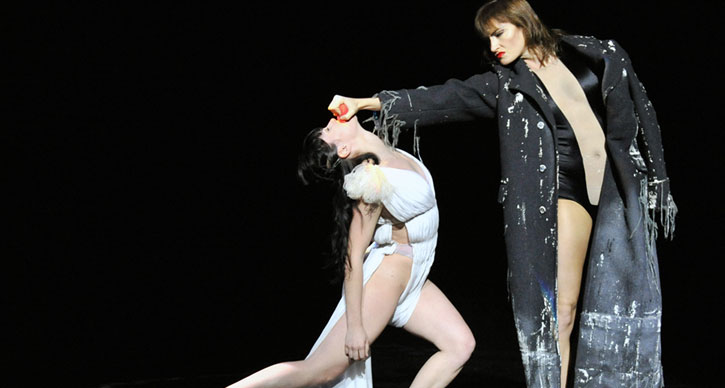Once Upon a Time, in a land called The Power Center…
Photo: A scene in Snow White by Ballet Preljocaj.
Every great story rests upon a conflict of good and evil. As children, we might encounter lessons from this kind of conflict through fairy tales, morals and legends. We hear frightening tales with themes of greed, lust, disobedience, and consequences that most often resolve with the poetic justice of a happily-ever- after ending. These age-old tales are an imaginative vehicle for children to relate to the dark side of human nature and to understand the power of choice and free will.
Fairy tales are not just for children however. There’s been an increase in fairy-tale prime time TV, ABC’s Once Upon a Time and NBC’s Grimm, for example, as well as a surge in live-action movies, Mirror, Mirror and Snow White and the Huntsman, to name a couple. As adults, we still love these stories and we still relate to their symbols and themes.
UMS is presenting two artists whose work is influenced by fairy tales: Robert Lepage’s The Andersen Project and Snow White re-staged by Ballet Preljocaj.
The Andersen Project is inspired by the life of Hans Christian Andersen and highlights the fairy tale “The Dryad,” which is set in nineteenth century Paris and follows a young dryad who lives within chestnut tree on the outskirts of the city. The dryad longs to see the Paris she hears about in the stories of those who travel past her. When her wish is granted, she is moved the heart of the city, but her happiness there is short-lived. As Her true desire is not for the city, but for the freedom of movement, it turns out. When this wish is granted, it comes with a heavy cost. Read the whole story.
The Andersen Project also references Andersen’s “The Shadow.” In “The Shadow,” a man loses his own shadow. One night, it returns, knocking on his door and appearing almost human. The shadow grows richer and fatter, while the man grows poorer and weaker. In fact, the man is so ill that his shadow proposes a trip to a health resort, on the condition that the shadow can act as the master. At the resort, the shadow meets a princess, and later when the two are about to be marry, the shadow offers the man a position within the castle if he agrees to become his own shadow permanently. In the end, the secret swap is revealed and the consequences are deadly. Read the whole story.
We interviewed The Andersen Project’s lead actor Yves Jacques. Start at 3:16 mark to learn about how old ways of storytelling influenced director Robert Lepage’s construction of this project.
Snow White may be a more familiar story for most. Choreographer Angelin Preljocaj explains that his narrative ballet is not the myth or legend of Snow White, but the story of Snow White herself. He follows the Grimm brothers’ version version but adds small variations. The wicked stepmother is the central character of the tale. He examines her through her narcissistic determination not to give up on seduction and on her role as a woman, even if this means sacrificing her stepdaughter. Do you need a Snow White refresher? Read the whole story.
We are living during a climatic time in history and our choices can be felt globally thanks to technology. Is it any wonder that artists are turning to the world of fairy tales to highlight the fight between good and evil or the power of choice? Fairy tales allow us to reach into our imagination and to examine the good and evil that reside in all of us.
Why do you think fairy tales are on the rise? What are your favorite fairy tales?
People are Talking: UMS Night School – Session 4
UMS Night School is a free and open to the public series of “classes”, which include a 30-minute discussion of each performance in Pure Michigan Renegade, plus a 60-minute intro session for the next performance on the series. You’ll find follow-up conversation, coverage, and materials here on the Lobby.
 See someone with this button? Start a conversation about ‘renegade’ works.
See someone with this button? Start a conversation about ‘renegade’ works.
SYLLABUS
HOMEWORK
“Required Reading” and “Required Watching” from Malcolm Tulip, Associate Professor of Theatre at U-M
1. The Turnip Princess: a newly-discovered fairy tale
“Once upon a time, the historian Franz Xaver von Schönwerth collected fairytales in Bavaria, which were locked away in an archive until now.”
2. Interview with Robert Lepage for Theatre Music Canada.
In Lypsinch (2007) Lepage intends to “show us a mosaic of human struggles for identity, to assemble a composite portrait of contemporary society voicing over and dubbing out our primal emotional needs. Lepage wants to make us aware of how we control and doctor the sounds surrounding us to cover up the voices of those in genuine need.” via Village Voice
3. Director Robert Lepage Speaks on what inspired him to create The Nightingale & Other Short Fables, a collection of works by composer Igor Stravinsky that made its world premier in October 2009.
4. More about The Andersen Project
A slideshow of images from the production
Preview in Paris Voice: “the piece is not a retelling of any one of Anderson’s tales but rather an open-ended study, undertaken to examine, create around and perhaps finally understand better both the creator and his work.”
5. More about Hans Christian Andersen
The Hans Christian Andersen Center (with complete works)
The Dryad
The Shadow
Elsewhere on the Lobby:
Our interview with The Andersen Project’s lead actor Yves Jacques, and 5 Things to Know About The Andersen Project.
YOU SUGGESTED…
We’ll add your suggestions for further reading, listening, and watching here.
What did you think of this session of Night School? What’s still not making sense? What are you excited about?



